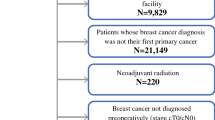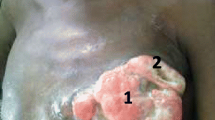Abstract
Background
Breast cancer is one of the most common cancers in female adolescent and young adults (AYA; age 15–39 years). However, few data exist detailing either in situ or invasive breast cancer in male AYAs.
Methods
All male AYA breast cancer cases were identified in the National Cancer Data Base (1998–2010). Demographics, tumor, and treatment predictors of overall survival (OS) were determined for both patients with in situ and invasive tumors.
Results
Of 677 male AYAs, 122 patients (18 %) had in situ breast cancer, while 555 patients (82 %) were found to have invasive breast cancer. Compared to in situ breast cancer, invasive breast cancer in male AYAs was less likely to occur in patients with private or managed care insurance (p = 0.003) or <20 years of age (p = 0.028). In patients with invasive breast cancer, lower OS was associated with age ≤25 years (p = 0.006), black race (p = 0.018), not having Medicaid/Medicare/government/military insurance (p < 0.001), the lowest socioeconomic status (p = 0.001), higher overall stage (p < 0.001), T stage (p < 0.001), nodal stage (p < 0.001), and M stage (p < 0.001), as well as not having any surgery (p < 0.001) or nodal evaluation at surgery (p < 0.001). After controlling for competing factors, only age ≤25 years (hazard ratio 3.064, 95 % confidence interval 1.216–7.720) and not having nodal evaluation (hazard ratio 3.070, 95 % confidence interval 1.423–6.626) predicted decreased OS.
Conclusions
Younger age and not having nodal evaluation at the time of surgery are associated with decreased OS in AYA male patients with invasive cancer. This highlights the need to perform axillary node sampling through sentinel node biopsy at the time of mastectomy in these young male patients.


Similar content being viewed by others
References
Siegel RL, Miller KD, Jemal A. Cancer statistics, 2015. CA Cancer J Clin. 2015;65:5–29.
Fentiman IS, Fourquet A, Hortobagyi GN. Male breast cancer. Lancet. 2006;367(9510):595–604.
Anderson WF, Jatoi I, Tse J, Rosenberg PS. Male breast cancer: a population-based comparison with female breast cancer. J Clin Oncol. 2010;28:232–239.
Contractor KB, Kaur K, Rodrigues GS, Kulkarni DM, Singhal H. Male breast cancer: is the scenario changing? World J Surg Oncol. 2008;6:58.
Bradley KL, Tyldesley S, Speers CH, Woods R, Villa D. Contemporary systemic therapy for male breast cancer. Clin Breast Cancer. 2014;14:31–39.
Rushton M, Kwong A, Visram H, Graham N, Petrcich W, Dent S. Treatment outcomes for male breast cancer: a single-centre retrospective case–control study. Curr Oncol. 2014;21:e400–e407.
Zaenger D, Rabatic BM, Dasher B, Mourad WF. Is breast conserving therapy a safe modality for early-stage male breast cancer? Clin Breast Cancer. 2016;16:101–104.
Gabriel CA, Domchek SM. Breast cancer in young women. Breast Cancer Res. 2010;12:212.
Derouen MC, Gomez SL, Press DJ, Tao L, Kurian AW, Keegan TH. A population-based observational study of first-course treatment and survival for adolescent and young adult females with breast cancer. J Adolesc Young Adult Oncol. 2013;2:95–103.
Sadler C, Goldfarb M. Comparison of primary and secondary breast cancers in adolescents and young adults. Cancer. 2015;121:1295–1302.
Tricoli JV, Seibel NL, Blair DG, Albritton K, Hayes-Lattin B. Unique characteristics of adolescent and young adult acute lymphoblastic leukemia, breast cancer, and colon cancer. J Natl Cancer Inst. 2011;103:628–635.
Kennedy RD, Boughey JC. Management of pediatric and adolescent breast masses. Semin Plast Surg. 2013;27:19–22.
Ambrosone CB, Ciupak GL, Bandera EV, Jandorf L, Bovberg DH, Zirpoli G, et al. Conducting molecular epidemiological research in the age of HIPAA: a multi-institutional case–control study of breast cancer in African-American and European-American women. J Oncol. 2009;2009:871250.
Lerro CC, Robbins AS, Phillips JL, Stewart AK. Comparison of cases captured in the national cancer data base with those in population-based central cancer registries. Ann Surg Oncol. 2013;20:1759–1765.
Mettlin CJ, Menck HR, Winchester DP, Murphy GP. A comparison of breast, colorectal, lung, and prostate cancers reported to the National Cancer Data Base and the Surveillance, Epidemiology, and End Results Program. Cancer. 1997;79:2052–2061.
American College of Surgeons. Facility oncology registry data standards. 2011. http://www.facs.org/cancer/ncdb/cocmanuals.html.
SEER coding and staging manuals. 2013. http://seer.cancer.gov/tools/codingmanuals/.
American Joint Committee on Cancer; American Cancer Society. Breast cancer staging, 7th ed. 2009. https://cancerstaging.org/references-tools/quickreferences/Documents/BreastMedium.pdf.
SEER Program coding and staging manual. Appendix C: surgery codes. 2013. http://www.seer.cancer.gov/archive/manuals/2013/AppendixC/breast/surgery_codes.pdf.
Lewis DR, Seibel NL, Smith AW, Stedman MR. Adolescent and young adult cancer survival. J Natl Cancer Inst Monogr. 2014;2014:228–235.
Mabry H, Giuliano AE. Sentinel node mapping for breast cancer: progress to date and prospects for the future. Surg Oncol Clin N Am. 2007;16:55–70.
Flynn LW, Park J, Patil SM, Cody HS, Port ER. Sentinel lymph node biopsy is successful and accurate in male breast carcinoma. J Am Coll Surg. 2008;206:616–621.
Maraz R, Boross G, Pap-Szekeres J, et al. The role of sentinel node biopsy in male breast cancer. Breast Cancer. 2016;23:85–91.
Giordano SH, Buzdar AU, Hortobagyi GN. Breast cancer in men. Ann Intern Med. 2002;137:678–687.
Giordano SH, Cohen DS, Buzdar AU, Perkins G, Hortobagyi GN. Breast carcinoma in men: a population-based study. Cancer. 2004;101:51–57.
Ribeiro G, Swindell R. Adjuvant tamoxifen for male breast cancer (MBC). Br J Cancer. 1992;65:252–254.
Giordano SH, Valero V, Buzdar AU, Hortobagyi GN. Efficacy of anastrozole in male breast cancer. Am J Clin Oncol. 2002;25:235–237.
Carmona-Bayonas A. Potential benefit of maintenance trastuzumab and anastrozole therapy in male advanced breast cancer. Breast. 2007;16:323–325.
Scott-Conner CE, Jochimsen PR, Menck HR, Winchester DJ. An analysis of male and female breast cancer treatment and survival among demographically identical pairs of patients. Surgery. 1999;126:775–780.
Saadatmand S, Bretveld R, Siesling S, Tilanus-Linthorst MM. Influence of tumour stage at breast cancer detection on survival in modern times: population based study in 173,797 patients. BMJ. 2015;351:h4901.
Mulye TP, Park MJ, Nelson CD, Adams SH, Irwin CE Jr, Brindis CD. Trends in adolescent and young adult health in the United States. J Adolesc Health. 2009;45:8–24.
Acknowledgment
The data used in this study was derived from a deidentified NCDB file. The American College of Surgeons and the Commission on Cancer have not verified and are not responsible for the analytic or statistical methodology used, or any conclusions drawn from this data by the investigators.
Disclosure
The authors declare no conflict of interest.
Author information
Authors and Affiliations
Corresponding author
Rights and permissions
About this article
Cite this article
Flaherty, D.C., Bawa, R., Burton, C. et al. Breast Cancer in Male Adolescents and Young Adults. Ann Surg Oncol 24, 84–90 (2017). https://doi.org/10.1245/s10434-016-5586-4
Received:
Published:
Issue Date:
DOI: https://doi.org/10.1245/s10434-016-5586-4




